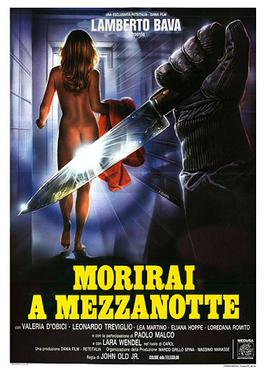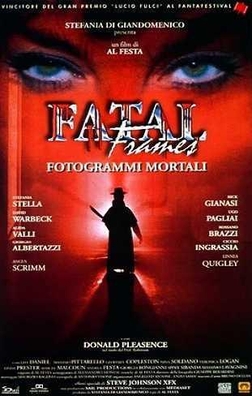
Lamberto Bava is an Italian film director. Born in Rome, Bava began working as an assistant director for his director father Mario Bava. Lamberto co-directed the 1979 television film La Venere d'Ille with his father and in 1980 directed his first solo feature film Macabre.

Opera is a 1987 Italian giallo directed and co-written by Dario Argento and starring Cristina Marsillach, Urbano Barberini, Daria Nicolodi, and Ian Charleson. The film's plot focuses on a young soprano (Marsillach) who becomes involved in a series of murders being committed inside an opera house by a masked assailant. The film features music composed and performed by Brian Eno, Claudio Simonetti, and Bill Wyman.

Werewolf Woman, also known as The Legend of the Wolf Woman, is a 1976 Italian horror film directed by Rino Di Silvestro.

Body Count is a 1986 Italian slasher film directed by Ruggero Deodato. The film is about a group of vacationing teenagers who enter an abandoned camp site that was formerly an Indian burial ground. One by one, they begin to be killed off.

Delirium is a 1987 Italian giallo film directed by Lamberto Bava and starring Serena Grandi, David Brandon, George Eastman and Daria Nicolodi. The film is about Gioia, the owner of the adult Pussycat magazine. She is harassed by a killer who sends her photos of her co-workers with her own erotic photography in the background.

Phantom of Death (Italian: Un delitto poco comune, lit. 'An Uncommon Crime' is a 1988 Italian giallo film directed by Ruggero Deodato. It starred Michael York, Donald Pleasence and Edwige Fenech.

Sette note in nero is a 1977 Italian giallo film directed by Lucio Fulci and co-written by him with Roberto Gianviti and Dardano Sacchetti. Sette note in nero stars Jennifer O'Neill, Gianni Garko, Marc Porel, and Ida Galli. The film involves a woman who begins experiencing psychic visions that lead her to discover a murder; her husband is charged with the killing. The psychic must embark on an investigation with a paranormal researcher to clear her husband's name of the crime.

Col cuore in gola is a 1967 giallo film directed by Tinto Brass. It is loosely based on the novel Il sepolcro di carta written by Sergio Donati. The film used storyboards from cartoonist Guido Crepax. It has been released under several titles including Deadly Sweet and I Am What I Am.

The Blood Stained Shadow Italian giallo film co-written and directed by Antonio Bido.The film follows a professor returning to his home of a coastline Italian village, where a woman is strangled like a young girl who was murdered years ago, before sinners in the town start dying as well.

Nothing Underneath is a 1985 Italian psychological slasher film directed by Carlo Vanzina and starring Renée Simonsen, Tom Schanley, and Donald Pleasence. The film follows a Yellowstone National Park ranger in Wyoming who travels to Milan to visit his sister, a fashion model, after having a vision of her being murdered; upon arriving in Italy, however, he finds her missing.

The Killer Is on the Phone is a 1972 giallo film directed by Alberto De Martino. It was released in the U.S. in July, 1975. The film is set in Bruges, Belgium, and stars Telly Savalas and Anne Heywood. The story follows an attractive actress who suffers from amnesia and paranoia triggered by a chance encounter with a professional assassin, who in turn begins to follow her with his knife.

Sweets from a Stranger is a 1987 Italian thriller film directed and co-written by Franco Ferrini. The film is about a serial killer targeting sex workers. The women decided to band together to protect themselves, but their efforts are only partially successful as the killer continues their killing spree. As the police investigate, the sex workers group together to try and find some leads on their own.

A Black Veil for Lisa is a 1968 thriller film directed by Massimo Dallamano.

The House of the Yellow Carpet is a 1983 Italian giallo film directed by Carlo Lizzani.

Formula for a Murder is a 1985 Italian giallo film co-written and directed by Alberto De Martino.

The Murder Clinic is a 1966 slasher giallo film directed by Lionello De Felice and Elio Scardamaglia. It was produced by Elio Scardamaglia, Francesco Scardamaglia and Luciano Martino;. The screenplay was written by Martino and Ernesto Gastaldi from their own story. It stars William Berger, Françoise Prévost, Harriet White Medin, Mary Young and Barbara Wilson.

Midnight Killer is a 1986 Italian giallo film starring Valeria D'Obici and Leonardo Treviglio, and directed by Lamberto Bava.

Blood Delirium is a direct-to-video Italian horror film directed by Sergio Bergonzelli. The film involves the painter Saint Simon who loses his sanity after the death of his wife. Along with his butler Hermann, they meet a young pianist named Sybille who resembles his dead wife home to their castle. After Saint Simon discovers that blood from a murder victim re-inspires him artistically, he orders Hermann to seek out more women for him while Sybille is held captive in the castle.

Fatal Frames is a 1996 Italian giallo film directed by Al Festa. It stars his wife, singer Stefania Stella. The film is about the American music video director Alex Ritt who is hired to direct the latest Stefania stelle video in Rome. While there, he witnesses a brutal killing. By the time the police arrive, the body has vanished and no traces of blood are found. When Ritt witnesses a second murder with the same circumstances, he tries to discover the truth.

Arabella Black Angel is a 1989 Italian film directed by Stelvio Massi. The film stars Tinì Cansino as an unsatisfied married woman who lives a double life as a sex worker. She finds herself the main suspect in a series of murders and attempts to find the real killer.




















